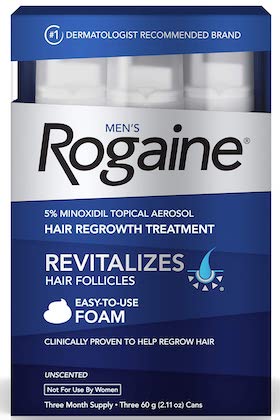Minoxidil, which is often referred to by the brand name Rogaine, is used by patients to try and stimulate hair regrowth and stop their remaining hair from continuing to thin. The key active ingredient in Rogaine is minoxidil and it has been available for use since 1986 when its 2% formula was introduced. It is approved by the Food and Drug Administration (FDA) for the treatment of both male pattern baldness and female pattern baldness, and it is available as a liquid or a foam over the counter.
Rogaine – A (Sort Of) Look at How it Works
 The first thing to know about how Rogaine works is that the way it works is not fully understood by the medical community. There is a theory that the anti-androgenic, anti-inflammatory, and vasodilating effects of minoxidil might be a contributing factor to the results it provides.
The first thing to know about how Rogaine works is that the way it works is not fully understood by the medical community. There is a theory that the anti-androgenic, anti-inflammatory, and vasodilating effects of minoxidil might be a contributing factor to the results it provides.
It is important for patients to know that Rogaine does not work for everyone. It is only effective in treating certain types of baldness and it must be used by the patient on a consistent basis. It is also likely that the patient will not grow back all of the hair they lost but some hair regrowth is possible.
Rogaine is considered to be a vasodilator by medical experts which means it is believed to partially enlarge hair follicles treated by the medication. In turn, it is believed that this allows the growth phase of the hair to last longer. No matter how it works, the results will only be maintained as long as the patient continues to use the product on an ongoing basis. If the person stops using Rogaine regularly, the hair will return to its earlier appearance and additional hair loss can occur.
Rogaine – Who Sees the Best Results?
As mentioned above, Rogaine can be used to treat both male pattern baldness and female pattern baldness. This type of hair loss is quite common and often happens to members of the same family. Rogaine has been shown to work for patients with hair loss that is hereditary and located at the area at the back of the head known as the vertex (located just under the crown). It is also a good option for men who have hair loss in the front of the scalp and women with a general thinning of their hair on the top area of the scalp.
One other group of people who often see good results is those who begin to use Rogaine once they start to see the first signs of hair loss on the scalp. It is not likely to help someone who is already bald. Rogaine should not be used by a person who uses hair products or chemicals that can cause hair loss, someone who has other reasons for their hair loss such as chemotherapy, alopecia areata, or thyroid disease, and anyone who is pregnant or currently breastfeeding a child.
Rogaine – Are There Any Side Effects?
In general. Rogaine is considered to be safe, and any side effects will not cause any serious health issues. Some of the most common side effects include irritation of the scalp, changes in the texture or color of the hair, and hair growth in other areas that are adjacent to the treated area (such as the forehead).
There are some patients who are afraid that their treatment is not working correctly when they start because they might see a greater amount of hair shedding at this time. This is normal as the hair follicles are pushing out the old hair to make room for the growth of new hair.
Rogaine – When to Consult with a Doctor
Once a person starts to experience hair loss, it is best to contact a doctor as soon as possible in order to start treating the condition. Some of the early hair loss symptoms that can be noticed by patients include thinning hair, a more noticeable receding hairline, and the formation of a bald spot.
It is also important to talk to a doctor to make sure the person is an ideal candidate for the use of Rogaine. The loss of hair might be the result of an infection, a hairstyle that constantly pulls on the hair, or some other medical condition. These issues can be addressed by the doctor and treated without the need to use Rogaine on a daily basis.
The doctor will also set realistic expectations when it comes to how quickly the results will start to be seen and the extent of the results the patient can expect to achieve. It can take up to four months for some patients to see hair regrowth from the treatment. However, Rogaine can start to work within a few weeks even if the patient is not seeing any results. This is one of the reasons that realistic expectations are important as the patient needs to know what to expect and have a general timeline of when results will start to occur and/or become visible.